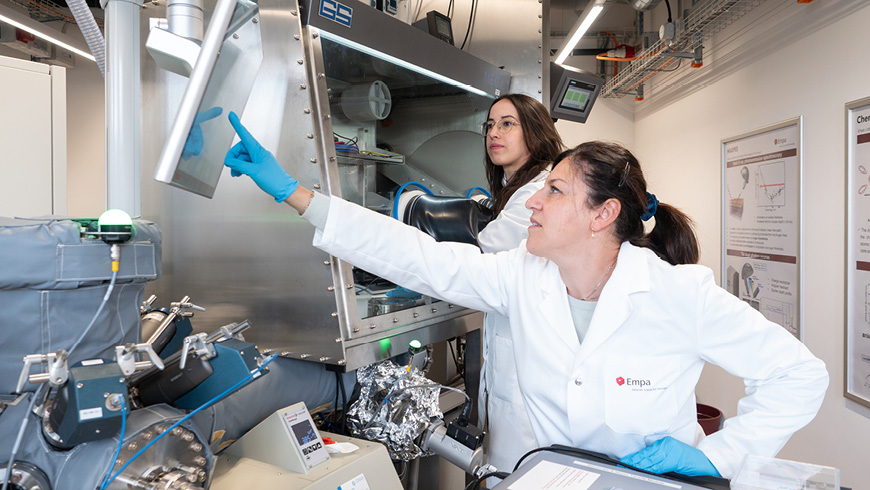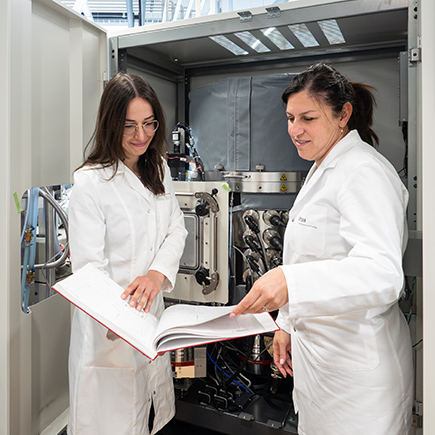Shield or gateway?
When hydrogen meets steel
Hydrogen damages steels. High-strength steels, particularly those used to construct bridges, high-rise buildings and oil and gas infrastructure, are susceptible to embrittlement caused by atomic hydrogen coming from the environment. The complex mechanisms behind this are not yet fully understood. Native oxide films on steel can act as barriers to block hydrogen from entering the steel workpiece. Empa researchers want to investigate the interaction of hydrogen with the thin oxides on steel with unprecedented spatial and temporal resolution.

On the night of September 11, 2024, an approximately 100-meter-long section of the Carola Bridge in Dresden collapsed into the Elbe River. The culprit: cracks in the bridge's steel tension structure caused by hydrogen. The Carola Bridge is by no means the first building to be affected by hydrogen. Other well-known examples include the London skyscraper 122 Leadenhall Street, popularly known as the Cheesegrater, and the partial replacement of the Bay Bridge in San Francisco. In both cases, failure of the steel bolts resulted in renovation costs running into millions.
The process is known as hydrogen embrittlement. Certain corrosion processes in the presence of water release atomic hydrogen – the smallest element in the periodic table – at the surface of steel components. Owing to its small size, hydrogen easily diffuses into the steel, promoting crack formation and propagation.
The fact that hydrogen attacks metals has been known since the 19th century. However, the complex mechanisms behind hydrogen embrittlement are still not fully understood – despite a plethora of studies. Empa researchers from the Joining Technology and Corrosion Laboratory are now investigating an aspect of hydrogen embrittlement that has received very little attention to date: the interaction of hydrogen with the so-called native oxide layer on steel.
The native oxide layer, also known as the passivation layer, is a thin layer that forms naturally on the surface of the majority of metals and alloys. It is what gives stainless steels their corrosion resistance. The type and composition of this layer, which is only a few nanometers thick, differs from steel to steel. Some oxides are significantly more stable and resistant to hydrogen than others, thus shielding the steel from embrittlement. This is what Empa researchers Chiara Menegus and Claudia Cancellieri set out to investigate. They are focusing specifically on the interface between the metal and its oxide layer. “Hydrogen accumulates in regions where the material is disordered,” explains doctoral student Menegus. “The metal-oxide interface is one such area.”

Innovative experiments ...
Studying hydrogen in steel is challenging. The light element cannot be directly tracked using most conventional analysis methods. And the experiments must take place in the absence of all other environmental factors such as oxygen and moisture – otherwise, complex interactions arise that can mask the influence of hydrogen. The final challenge is the interface itself: “It is difficult to examine a buried interface inside the material without destroying the sample,” says Claudia Cancellieri, research group leader in the Joining Technologies and Corrosion Laboratory.
The researchers master these challenges with an innovative experimental setup. In the first year of her doctorate, Chiara Menegus developed an electrochemical cell in which the steel sample is mounted. Water is placed on one side of the sample and the inert noble gas argon on the other. By applying an electrical voltage, atomic hydrogen is generated from the water. The hydrogen diffuses through the thin sample until it reaches the oxide layer on the opposite side, where it interacts with the native oxide. “This allows us to isolate the interaction of atomic hydrogen with the native oxide from the uncontrolled environment,” explains Menegus. All steps – from assembling the cell to analyzing the sample – take place in a protective atmosphere, inside a glovebox.
... and advanced methods
To characterize the samples, the researchers use an analysis technique that is unique in Switzerland: hard X-ray photoelectron spectroscopy (HAXPES, see info box). This spectroscopy method uses high-energy X-rays to determine the type and chemical state of atoms in a material; not just on the top surface, but up to 20 nanometers deep – enough to detect the oxide layer, which is around five nanometers thick, and the interface with the steel underneath.
Although hydrogen itself cannot be directly detected with this method, the researchers have already been able to clearly demonstrate its effects on the oxide layer. “The first tests show that the hydrogen degrades the protective oxide layer,” says Menegus. She now wants to investigate oxides on different iron-chromium alloys as well as some common steels. Later on, the researchers will collaborate with the Ion Beam Physics Lab at ETH Zurich to directly determine the hydrogen content in the samples in real time, using a complex particle accelerator method. “We hope to better understand the effect of hydrogen on the native oxide layers and find particularly resistant oxide forms,” summarize Menegus and Cancellieri. Their findings could lead to the construction of more durable bridges – as well as to better infrastructure for the storage and transportation of green hydrogen.
HAXPES

HAXPES, short for Hard X-ray Photoelectron Spectroscopy, is an analysis method based on the photoelectric effect, for the discovery of which Albert Einstein was awarded the Nobel Prize in Physics in 1921. Electrons are “kicked out” of the material using X-rays, allowing conclusions to be drawn about the chemical nature of the sample. While conventional X-ray photoelectron spectroscopy is limited to the surface of the material, the “hard” version – HAXPES – probes much deeper into the sample thanks to high-energy X-rays and allows precise characterization of multi-layered structures and buried interfaces. HAXPES has applications in the development of microelectronic devices, solid-state batteries and functional thin films as well as in catalysis and corrosion research. The only facility in Switzerland is located in Empa's Joining Technologies and Corrosion Laboratory in Dübendorf.
Dr. Claudia Cancellieri
Joining Technologies and Corrosion
Phone +41 58 765 43 24
Chiara Menegus
Joining Technologies and Corrosion
Phone +41 58 765 39 63
Surfaces and Interfaces
Totally superficial? You bet! What might be a bit of a character flaw in a person is actually a good thing in materials science. Because, chemically speaking, it's what happens on the surface that counts. A sound understanding of surfaces and interfaces enables everything from better electronics to more robust bridges. Whether it's biological compatibility in implants, antibacterial coatings in hospitals, or catalytic processes in the production of synthetic fuels – surfaces are crucial to all of these.
Read the latest EmpaQuarterly online or download the PDF version.
-
Share






